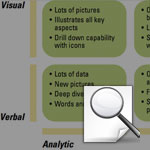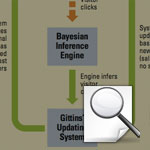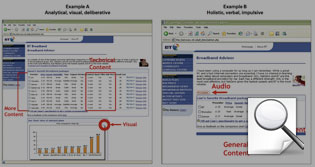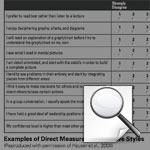Morph the Web to Build Empathy, Trust and Sales
We’ve long been able to personalize what information the Internet tells us — but now comes “Web site morphing,” and an Internet that personalizes how we like to be told. For companies, it means that communicating — and selling — will never be the same.
Topics
The leading question
What are the consequences if the Web can connect with users in the cognitive style they prefer?
Findings
- As salespeople and anyone trying to communicate already knows, individuals process information in different ways. Messages delivered in the matched “cognitive style” will be more effective.
- Advances in technology and behavioral science are beginning to enable an “empathetic Web” to emerge — a Web that can figure out for itself how a user wants to be talked to.
When we talk to someone, we often feel that communication is more effective if we are “on the same wavelength” with them. If they “get it,” we feel empathy and trust. We’re more likely to believe their statements or even buy what they’re selling. While this trust and empathy come from good communication, good communication is more than just content. It depends not only on what is in the message, but also on how the message’s content is delivered — in particular, how well the message’s delivery style matches the way the listener (or Web site visitor, or customer) thinks. We call these thinking styles “cognitive styles.” They define how people process information.
Some people are analytical and want to take messages apart and study each component in depth, while others look holistically at the message and react to it. Presenting an analytical case to someone who processes ideas holistically is not likely to be effective, and vice versa. Some people are deliberative and want to carefully consider ideas, while others are impulsive and “go with their gut.” Some people think with pictures, while others process information in words. Matching your presentation to the cognitive style of the Web site visitor or customer is critical for success, especially if you are trying to persuade that person to buy your product.
Good salespeople have known this for years, of course. The best ones carefully diagnose how the client thinks and then modify their pitch to match the customer. This sales approach, often instinctive, enables the salesperson to vary the presentation of information depending on the cognitive style of the customer.
Now, through Web site morphing, the Internet is beginning to do the same.
Morphing increases sales. A recent experimental study at MIT demonstrated that Web-originated purchase intentions for a large global telecommunications company’s broadband product could increase 20% after morphing the site to match individual cognitive styles. For example, giving analytic potential customers more data and technical detail, reducing the complexity for holistic information processors, giving impulsive users succinct recommendations, and providing engaging learning experiences to deliberative customers made it more likely that these Web site visitors would make a purchase after visiting the site.
MORPHED ADS COMMUNICATE AS THE USER LIKES
These Web-morphed ads are versions of the same sales step — the commitment phase — but they talk to customers in the “cognitive style” that each customer prefers.

Think of how morphing differs from the way the Web works now. Web site designers realize that people come to a site with different information needs. Classical site design puts everything within easy reach through a multitude of tabs, drop down menus and search boxes. For many Web site visitors this strategy results in a crowded, complex site. Visitors who are analytical and deliberative find the site effective (a typical stereotype of IT programmers), but holistic and impulsive users find it difficult to use, complex to navigate and confusing. Communication is handicapped, and the Web site forgoes opportunities to build trust and empathy.1 Sales are lost. Recognizing this, some sites use large visuals, lots of open space, calls to action and basic brand communication. These sites are effective for holistic, impulsive and visual users (a stereotypical style for marketing designers at advertising agencies), but such sites fail for analytical and deliberative information processors. When the site is seen as “fluff” by these visitors, sales are lost.
Now imagine a Web site that detects a visitor’s cognitive style and “morphs” its look and feel to that visitor’s style. This site will enhance empathy and trust through better communication and be more effective in its goals (such as selling broadband service). Such Web sites are now possible. Here we’ll describe a new methodology that modifies Web pages dynamically to match a customer’s cognitive style. After a “priming” study, the site infers a customer’s cognitive style from his or her early clicks and then changes its look and feel to match that style. More importantly, the site automatically learns the best “morph” to provide for each cognitive style using “Gittins indices.”2 The technical algorithms that make this methodology work are publicly available3 and ready to implement. Applications are still in their infancy, but the potential for increased empathy, trust and sales effectiveness is driving pioneers to test such systems. You can build one yourself or use the consulting and advertising companies that will emerge to implement morphing. If you do not, your competitors probably will.
How Web Morphing Works
The Six Steps to Implementing Web Morphing on Your Site
Select the cognitive styles likely to describe your customers.
- Design Web site journeys that are likely to appeal to each segment of customers as described by their cognitive styles.
- Design initial Web pages (e.g., the home page) so that early clicks help identify customers’ cognitive styles.
- Undertake a priming study to measure click preferences for various cognitive-style segments.
- Program both the Bayesian Inference Engine and the Gittins updating strategy so that the Web site can (1) identify cognitive styles and (2) learn the best morph for a cognitive style.
- Launch the new Web site and reap the rewards as it automatically identifies the best morph to provide to each cognitive style.
- Periodically update Web pages to reflect changes in product offerings and changes in consumer tastes.
Cognitive styles include how we perceive, think and solve problems. They are believed to be fixed early in life and have a high degree of persistence across various decision situations.4 Many dimensions of cognitive style have been proposed and tested. We found that analytic vs. holistic, impulsive vs. deliberative, visual vs. verbal and leader vs. follower were effective constructs for marketing decision making, but other cognitive-style dimensions have been proposed and could be used in other contexts (for instance: quantitative vs. qualitative, technical vs. nontechnical, innovators vs. late adopters, flexible vs. inflexible).
Behavioral theory suggests hypotheses by which Web sites can be designed to match cognitive styles. We start with these hypotheses, but our system is self-learning and adjusting. If we guess wrong or implement wrong, the system finds the best morph even if it does not fit behavioral theory.
For example, “Cognitive Styles and Web Page Characteristics” displays characteristics appropriate for each of four cognitive-style profiles derived from the combination of analytic vs. holistic and verbal vs. visual dimensions. This example is only illustrative, though; in our initial morphing application, we used four cognitive-style dimensions for a total of 16 (= 2 x 2 x 2 x 2) segments. (The example also suggests characteristics for the third dimension: impulsive vs. deliberative.)
One size clearly does not fit all. “Advisor for Two Different Cognitive Styles” illustrates ways in which a specific site — a BT Group plc (formerly British Telecom) test site for a broadband advice center — varied for cognitive style. Example A shows the advisor page, with added technical content and graphs, as a morph targeted to analytical, visual and deliberative users. Example B shows a morph with less (and more general) content, plus the capability for visitors to listen to information. A priori we expect this morph to be best for holistic, verbal and impulsive users.
The Technical Backbone of Web Morphing
To make Web morphing happen, a lot goes on behind the scenes. The formal Bayesian Inference Engine begins with a priming study that needs to be done only once and only for a sample of a Web site’s visitors. (We provide paid incentives to the sample to answer the cognitive-style questions and other priming questions.) In that study we measure cognitive styles directly. Good scales exist to measure cognitive styles. Then, for each cognitive style, we measure (estimate) preferences for the characteristics of clicks. These preferences drive the on-the-fly inference.
Armed with the preferences from the priming study, we use Bayes’ Theorem to infer cognitive styles from the observed clicks. While the intuition may be simple, implementation is more complicated.i
In classical statistics we might consider “factorial” experiments. For example, we might randomly assign visitors to each of the morphs we are considering; there are four, and there were eight in the BT broadband services application. We would then observe purchases (or not) for each morph and each cognitive style for a total of 128 experimental cells in the BT application (16 cognitive styles x 8 morphs). This strategy is commonly implemented by systems such as Google’s Web site Optimizer. But we can do much better than that.
Suppose we have already observed enough clicks to identify a visitor’s cognitive style and suppose that this is the nth visitor with that cognitive style. Suppose further that prior visitors with that cognitive style have already been given various morphs and we have some beliefs about how likely it is that the nth will make a purchase if we give that visitor morph m. That is, we have a best estimate of the probability for each morph, and we have a measure of our uncertainty about that probability for each morph. One naïve strategy might be to simply give the visitor the morph with the highest probability for his or her cognitive style. We call this “exploitation” because it leads to the highest immediate reward.
A moment’s reflection reveals that this may not be the best strategy. Suppose the probability of purchase for Morph 1 is 38% and we have very little uncertainty about our estimate. Now suppose the probability for Morph 2 is 37% but we are very uncertain about our estimate. We might want to experiment with Morph 2 for a while. If our experimentation resolves uncertainty and we find the probability is really 40%, we will use Morph 2 in the future and increase sales. We call experimentation with Morph 2 “exploration.” (This is, qualitatively, like buying an option on Morph 2.)
However, exploration is costly. The explored morph has a lower probability and, hence, exploration has lower expected sales. We will only choose Morph 2 if the long-run gains from exploration are larger than the short-run loss because we have forgone exploitation. Too much exploration and the morphing strategy will not be profitable. When we choose among all the potential morphs for a cognitive style, we must find a way to balance exploration with exploitation.
Balancing exploration and exploitation while learning dynamically is a complicated and difficult problem, but, fortunately, pioneering research by John Gittins of Oxford University has provided a computationally fast solution called “Gittins indices.” We summarize each potential morph (for each cognitive style) with an index and choose the morph with the highest index. We then update the index when we observe whether or not the nth visitor purchases. Over time the indices converge to the true probabilities as the system learns.
The Gittins strategy is optimal. That is, there is no better way to balance exploration and exploitation in this situation. The strategy is much more efficient than naïve experimentation and quickly learns the best morph to give to visitors in each cognitive state.ii
Hypotheses about cognitive style and preferences for Web design characteristics provide a starting point. But to be effective, the morphing system must observe, learn and adapt automatically so that each visitor gets the morph that is most effective for his or her cognitive style. In the BT application, most effective meant creating the highest chance of selling broadband service, but in other applications Web site designers might have other goals, such as increasing brand empathy, consumer information, software downloads or recommendations.
Cognitive Styles and Web Page Characteristics
Cognitive styles include how we perceive, think and solve problems. There are many dimensions that help define how individual styles differ — this grid describes how a Web site would present information differently according to just two pairs of cognitive preferences (visual vs. verbal and analytic vs. holistic). A Web-morphing site figures out for itself how each user likes to think based on how that user clicks through the site.

“How a Web Site Morphs” illustrates the basic logic. By the time a number of visitors have come to the site, we have learned which site morph to give to visitors with each cognitive style. We have also learned something about the population of potential visitors, and we have beliefs about which is the best morph to provide when a new visitor enters the site. During the visit, we observe a visitor’s clicks. If the site is designed well, the visitor’s free choice of clicks will tell us something about his or her cognitive style. Using a Bayesian Inference Engine, we estimate the visitor’s cognitive style. Based on our still-evolving assignment rules (assignment meaning which morph to serve up), we learn the best matching of morphs and specific cognitive styles and provide the morph we believe is best for the visitor. The visitor continues exploring the Web site and either makes a purchase or does not. Based on that purchase opportunity result, we update our assignment rules for the next visitor. Over many visitors, the site learns the best assignment rules. If the population of users changes or their tastes change, then the learning system continues to update assignment rules, always seeking the most profitable morphing strategy.
“Inferring Cognitive Style” illustrates the intuition by which cognitive styles are inferred from observed click behavior. In real applications we learn visitors’ preferences from a priming study, but for this illustration assume that visitors’ preferences are based on cognitive-style theory. The basic idea is that if the visitor is given a choice of clicks, and if the clicks reflect Web site characteristics that are differentially preferred by visitors with different cognitive styles, then we should be able to infer cognitive styles from the clickstream.
How a web site morphs
The Web site “learns” as visitors use it. Their choices of what to see (their “clicks”) are analyzed in real time together with all visitor behavior to divine the style each prefers.

Suppose a potential customer (visitor) chooses freely to go first to “Compare Plans.” The Web site is constructed so that the visitor knows he or she will see lots of data on characteristics of many plans. If the visitor clicks first on this portion of the site, we begin to infer that the visitor is analytic. Alternatively, suppose the visitor chooses to click first on “Broadband Advisor.” The visitor does so knowing that he or she will get overall advice without having to delve into charts and graphs. Such visitors are more likely to have holistic styles. Similarly, the “Learning Center” might imply a more deliberative and analytic style, and the “Broadband Community” might imply a more deliberative and holistic style.
Naturally, a single click provides only a first glimpse at the visitor’s cognitive style, but multiple clicks help us infer the visitor’s cognitive style more accurately. Every click gives us more information — the choice to look at graphs implies an analytic cognitive style; the choice to see pictures a visual cognitive style. Our applications suggest that roughly 10 clicks are sufficient for obtaining usable cognitive-style probabilities.
Inferring Cognitive Style
As customers make choices about what to see on a site (for instance, choosing “Compare Plans,” which means lots of data, instead of “Broadband Advisor”) the Web site gradually infers cognitive-style preferences.

Web site morphing complements other adaptive approaches. The underlying methods for Web site morphing, the Bayesian Inference Engine and Gittins updating strategies, draw on state-of-the-art research in statistical inference and machine learning. They expand upon applications in learning and in recommendation systems. For example, in distance learning, Web-based learning, library search, and adaptive hypermedia, systems often adapt material based on learning styles and knowledge levels.5 In these systems the visitor will use the system over a period of days or even weeks, so it is not unreasonable to measure cognitive styles (learning styles, knowledge levels) directly. Furthermore, most systems rely upon expert judgment to assign material. In Web site morphing we infer cognitive styles from clickstreams because site visitors do not have the patience to complete a battery of psychometric scales. Expert judgments are used in the initial design of potential morphs, but site morphing improves assignment of morphs to cognitive styles as it learns which morph assignments lead to the largest sales increases.
Web site morphing also complements Web-based systems that dynamically texture information for customers.6 For example, Amazon.com’s “collaborative filtering” system recommends books, music and other items to potential customers based on matching their tastes to the tastes of other customers. If a customer purchases Cryptonomicon by Neal Stephenson, Amazon.com might recommend other books that were purchased by customers who bought Cryptonomicon. Like collaborative filtering, Web site morphing learns “on the fly” the best morph to provide based on what worked for previous visitors who had the same cognitive styles — except that morphing changes how information is presented, not just what the site serves up.
How Do I Implement Web Site Morphing on My Site?
Successful Web site morphing implementation requires managerial leadership. We recommend a seven-step procedure. First, consider your customers and select the cognitive styles that are likely to distinguish their preferences for one or the other set of Web site characteristics. For a few examples, see “Cognitive Styles and Web Page Characteristics.” Hauser et al. provide more examples and a taxonomy that includes 11 candidate cognitive-style dimensions.7
Second, design Web site “journeys” — that is, paths through the site that are likely to appeal to visitors with the targeted cognitive styles. The better these journeys are designed, the better the raw material for the Web site morphing system. (Examples of a journey are viewable online at https://sloanreview.mit.edu.)
Third, design the home page and the initial Web pages so that they offer choices to visitors with different cognitive styles. Naturally, the home page should not be too crowded or complex, but judicious use of different Web site characteristics (text vs. pictures) will help the Bayesian Inference Engine quickly zero in on the visitor’s cognitive style. Creative Web site designs can develop more subtle and powerful initial-page differentiators. For one example, see “Inferring Cognitive Style.”
Fourth, undertake a priming study. The Web site morphing system infers cognitive styles and learns morph assignments, but it must begin someplace. The priming study is a market research study to measure consumer preferences for Web site characteristics. Respondents are often compensated because they must complete psychometric scales to identify their cognitive style. We recommend approximately 500 to 1,000 respondents.
Fifth, program the site. The Bayesian Inference Engine needs to calculate “likelihoods,” but these are readily done. The Gittins updating system requires simple computations and table lookup. All details and equations are available in Hauser et al.8 and can be implemented by skilled statisticians and IT professionals.
Sixth, launch the Web site. If everything was done right, you will reap rewards as the site adapts automatically to cognitive styles and, in doing so, increases trust, empathy, communication and, most importantly, achieves your goals, whether they be sales or another metric. We do caution that it might take a few thousand visitors before morph assignments stabilize, so Web site morphing is best for high volume sites.
Seventh, monitor and update. Preferences change, information changes, external events change and new products emerge. Periodically seed the Web site with different or modified morphs so that the site morphing system can learn whether or not changes are needed.
Why Isn’t Everyone Doing Morphing?
If morphing is a way to increase site conversion by up to 20%, why don’t we see all Web sites using it? First, Web site morphing is new; only a few companies are aware of and testing it (this list includes the BT Group, Google, France Telecom/Orange, General Motors and WPP). Diffusion is just beginning. Second, Web site morphing is not for everyone. The Gittins updating strategy requires enough visitors to learn morph assignments, and the 20% increase in sales must be sufficient to justify the priming study and the additional Web site programming. Third, site development is advancing rapidly. Development needs are prioritized as “must do” and “nice to do.” Reality happens. IT departments may not get beyond “must do”; morphing can be viewed as “nice to do.” As IT works down its priority lists, we expect to see more Web sites morph.
Morphing to build empathy on the Web is in its infancy, but innovative companies can use it to gain a competitive advantage. This is a field for companies that are innovators and willing to take the risk for significant potential benefits.
Where Will Morphing Take Us? (Or, Here Comes the Empathetic Web)
Cognitive styles are just the starting place for ways the Web will morph. We are now completing a study with Suruga Bank Ltd. in Japan on a Web site to sell “card loans.” (Card loans are like a line of credit on your card, but in Japan you must apply for a separate loan for these expenditures.) Although Japan is often viewed as a homogeneous culture, Japanese consumers may vary in their cultural as well as cognitive styles. We included cultural dimensions from studies by Hofstede, Steenkamp and Baumgartner, and Trompenaars and Hampden-Turner.9 The two cultural dimensions are hierarchical vs. egalitarian (view hierarchy with respect and elevated status vs. see all people at the same level) and individual vs. collective (maximize personal gain vs. work together for an overall societal benefit). Japan is traditionally hierarchical and collective, but some Japanese consumers see themselves as more egalitarian and individual. When we morphed the site to reflect these dimensions (e.g., hierarchical people saw a professorial advisor and egalitarian people were advised by a peer), we found evaluations of the site improved. Morphs included different presentations of data, advisors, fast solutions, learning centers, communities and personalization. Site content varied (individual benefits vs. group benefits) and colors changed (bright colors for individualistic visitors and subdued colors for hierarchical visitors), among other morphs. In the priming study, ratings increased significantly from a nonmorphing site to a morphing site on the relevant measures: trust (from 3.1 to 3.7 on a five-point scale), helpfulness (from 3.5 to 4.1), ease of use (from 3.3 to 3.9) and information identification (from 3.2 to 3.7). Visitors were more likely to consider and buy a loan card from Suruga (from 2.7% to 17.6% for consideration and from 13.4% to 18.0% for the probability of buying). These are promising results, potentially even larger than those achieved by the BT Group.
Managers might also try other variables, including innovators vs. late adopters, leaders vs. followers or tech savvy vs. low tech. A Web site experience for innovators would stress benefits of early adoption and acknowledge risks and benefits, but for late adopters it might include testimonials from previous adopters and emphasize data to show how risk is mediated. In each case, if click patterns on the Web site discriminate between these latent segments, inferences can be made from the clicks and the site experience can be varied to improve empathy and communication.
New applications — personal selling and advertising targeting. Marketing is communication, and morphing to cognitive styles enhances communication.10 Morphing might be extended to call centers if the inquiry to the call center comes after the Web site visit. For example, estimated cognitive styles might be used to route a call to a matching representative. An analytic and deliberative consumer might prefer to talk to a technically trained (and technically minded) representative. A holistic and impulsive consumer might prefer a warm, friendly and understanding person. Personal selling could also benefit from explicit matching to cognitive style. For example, if doctors were assigned to detailers for new drugs based on their cognitive style, sales could be increased. Some doctors are analytical and want all the scientific experimental data, while others want overall patient effectiveness and side effects information. If the detailer’s approach were matched to the doctor’s cognitive style, communication on the Web in advertising and in personal selling could be integrated into one cognitively optimized program.
Advertisers often target their advertising to the typical cognitive style in a product class: Cosmetics advertising is often holistic, visual and impulsive, while business-to-business advertising is often analytical, deliberative and verbal. But when customers vary in their cognitive style, “one size fits all” may not be the most effective advertising strategy. Targeted messages can build empathy and increase sales.
“Morphed Ads Communicate as the User Likes” illustrates four Chevrolet Aveo banner ads targeting four cognitive-style segments defined by analytic vs. holistic and visual vs. verbal styles. These ads target consumers at the final commitment phase of a car purchase (another morph-capable visitor dimension that is identified automatically from the clickstream). We have developed analogous alternatives for other phases in the buying process when people collect information and compare specific alternatives. For the final commitment phase and for visual, holistic Web site visitors, the advertisement is similar to a typical banner that is used today (like a print magazine ad). For an analytic, verbal visitor, the approach is very different: lots of content, small visuals and a banner that looks more like it is part of the site. Morphs for the other two cognitive-style segments are mixtures of these tactics.
Advertising morphing might also rely on clicks from other Web sites to identify cognitive styles. With the visitor’s permission, we might store cognitive styles on a cookie so the banner ad immediately matches the visitor’s cognitive style when he or she visits any of a range of sites selected by the advertiser. Our approach to advertising morphing extends existing behavioral targeting methods that commonly use patterns of clicks but do not make inferences on underlying cognitive states and do not include formal experimental learning based on Gittins’ updating strategies.
Morphing is possible in any case where communication can be varied in response to individual or clientele characteristics. Human resources could morph internal Web sites to provide individualized advice and Web site style to better communicate benefit options and selections such as health insurance, 401(k) choices or expense reimbursement. Communication with stockholders could be improved with sites that morph to match the stockholders’ investment style. Empathetic communication from government information Web sites, such as medicare.gov, might improve if it matched cognitive styles of the targeted public. The possibilities are endless.
Advisor for Two Different Cognitive Styles
These two Web pages are two morphed versions of the same “Broadband Advisor” page for British Telecom — one of them morphed for a cognitive style discovered to be “analytic, visual and deliberative,” the other for a “holistic, verbal, impulsive” user. Note how the technical information is presented differently.

Web site morphing improves communication and builds empathy, trust and sales, making the empathetic Web a real business opportunity. Early Web applications allowed great volumes of information to be accessed by users, and then enabled two-way communications. In the next generation, multiperson and community interactions were added. In the future, the Web can be customized dynamically by morphing communications to a visitor’s cognitive style. While the emergence of this empathetic Web is in its infancy, we can expect to see leading-edge applications that use morphing capabilities to implement systems that evolve from a simple backbone to an individually customized user interface that dynamically matches a visitor’s cognitive style.
References
1. Urban, G.L. “The Emerging Era of Customer Advocacy,” MIT Sloan Management Review 45, no. 2 (2004): 77-82; and Urban, G.L., F. Sultan and W.J. Qualls, “Placing Trust at the Center of Your Internet Strategy,” MIT Sloan Management Review 42, no. 1 (2000): 39-48.
2. Gittins, J.C. “Allocation Indices for Multi-Armed Bandits” (London: Wiley, 1989).
3. Hauser, J.R., G.L. Urban, G. Liberali and M. Braun, “Website Morphing,” Marketing Science 28, no. 2 (March-April 2009): 202-223.
4. Allinson, C.W. and J. Hayes, “The Cognitive Style Index: A Measure of Intuition-Analysis for Organizational Research,” Journal of Management Studies 33, no. 1 (January 1996): 119-135; Frederick, S., “Cognitive Reflection and Decision Making,” Journal of Economic Perspectives 19, no. 4 (2005): 25-42; Riding, R.J. and S. Rayner, “Cognitive Styles and Learning Strategies: Understanding Style Differences in Learning and Behavior” (London, U.K.: David Fulton Publishers, 1998); and Paivio, A., “Imagery and Verbal Processes” (New York, New York: Holt, Rinehart and Winston, 1971).
5. Chickering, D.M. and T. Paek, “Personalizing Influence Diagrams: Applying Online Learning Strategies to Dialogue Management,” User Modeling and User-Adapted Interaction 17, no. 1-2 (2007): 71-91; Frias-Martinez, E., S.Y. Chen and X. Liu, “Automatic Cognitive Style Identification of Digital Library Users for Personalization,” Journal of the American Society for Information Science and Technology 58, no. 2 (2007): 237-251; and Santally, M.I. and S. Alain, “Personalisation in Web-Based Learning Environments,” International Journal of Distance Education Technologies 4, no. 4 (October-December 2006): 15-35.
6. Ansari, A. and C.F. Mela, “E-Customization,” Journal of Marketing Research 40, no. 2 (May 2003): 131-145; and Montgomery, A.L., S. Li, K. Srinivasan and J. Liechty, “Modeling Online Browsing and Path Analysis Using Clickstream Data,” Marketing Science 23, no. 4 (fall 2004): 579-595.
7. Hauser et al., “Website Morphing.”
8. Ibid.
9. Hofstede, G., “Culture’s Consequences: Comparing Values, Behaviors, Institutions and Organizations Across Nations,” 2nd ed. (Thousand Oaks, California: Sage Publications Inc., 2001); Steenkamp, J.-B.E.M. and H. Baumgartner, “Assessing Measurement Invariance in Cross-National Consumer Research,” Journal of Consumer Research 25, no. 1 (June 1998): 78-90; and Trompenaars, F. and C. Hampden-Turner, “Riding the Waves of Culture: Understanding Cultural Diversity in Business” (London, U.K.: Nicholas Brealey, 1993).
10. Tybout, A.M. and J.R. Hauser, “A Marketing Audit Using a Conceptual Model of Consumer Behavior: Application and Evaluation,” Journal of Marketing 45, no. 3 (summer 1981): 82-101; Wernerfelt, B., “Efficient Marketing Communication: Helping the Customer Learn,” Journal of Marketing Research 33, no. 2 (1996): 239-246: and Wright, P.L., “The Cognitive Processes Mediating Acceptance of Advertising,” Journal of Marketing Research 10 (February 1973): 53-62.
i. Hauser et al., “Website Morphing.”
ii. Hauser et al. give all equations and derivations as well as simulations that illustrate how the Gittins strategy works. Technically, with the Bayesian Inference Engine, we know only the probability that a visitor is in a cognitive state, so we need to use the expected value of the Gittins index rather than the raw indices. This solution is no longer optimal per se but is very, very close to optimal.

